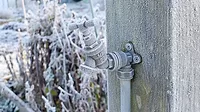Keep Your CSST Fittings Straight
Don’t Mix: CSST fittings aren’t interchangeable

Unlike heavy traditional rigid back pipe, CSST is a light and flexible gas piping system that goes by a variety of brand names in the U.S. market. Though it usually sports a distinctive yellow jacket, some manufacturers distribute their CSST with a conductive black jacket. How widespread is CSST? It’s estimated more than 800 million feet of it has been installed in the United States since it came to market in 1990. Current sales are approximately 55 million linear feet per year.
We sat down to discuss CSST with Andrew Dervin, Clay Jones and Michael Buchanan of VPC Global, the parent company of HOME-FLEX, LLC and manufacturer of HOME-FLEX CSST and gas appliance connectors. The talk began with why CSST was developed.
Japan learned the hard way that rigid pipes and earthquake zones are a bad mix, thanks to gas leaks and fires following major temblors in the island nation. So in the early 1980s Japanese researchers developed CSST. Research by the Gas Research Institute in the United States quickly followed. CSST was introduced here in 1990 following the adoption of ANSI standard LC-1 in 1989. This expansive standard covers the installation, manufacture and testing of tubing and fittings. It even covers the certification of qualified installers. All CSST products have to pass tests for safety and performance before they can be sold in the U.S. market.
“The standard is great for the market because it ensures customers know that any CSST sold in the United States is safe to use,” said VPC Global CEO Andrew Dervin.
So if all CSST is manufactured to the same standard, what sets the different brands apart? “Basically it’s the fittings,” Dervin said. “The standard establishes the performance benchmarks that tubing and fitting design must meet, not the specifics of how they are designed.”
This has led to a range of different and proprietary solutions to the shared problem of making a leak-proof seal between the tubing and a fitting that attaches to the gas piping system. For example, one manufacturer’s fitting has a retainer ring secured to the tubing between a flange and nut that are tightened together to create a seal. Other manufacturers use greased split-rings that flare against the fitting or a series of gaskets and o-rings compressed against the fitting to make the seal. Michael Buchanan, director of technical services at VPC Global, said that’s why you can’t use one manufacturer’s tubing with another’s fitting. “Every manufacturer’s tubing and fittings are designed and tested together — the standard doesn’t require or test for interpretability between manufacturers, so mixing the brands of tubing and fittings could be very dangerous,” Buchanan said.
Safety is the critical factor here. It’s vitally important CSST, like other potentially conductive systems — including rigid black pipe — be properly bonded to the structure’s grounding network. Since 2006, all U.S. CSST manufacturers have included specific bonding and grounding procedures in their installation requirements.
“Proper bonding is critical to ensure not only the proper dissipation of an electrical surge as a result of lightning strikes, but also to prevent a potential shock should someone come in contact with the CSST and another metal object in the structure connected to the grounding system,” Buchanan said.
When a system is properly bonded and grounded, excess electricity moves smoothly through the system to the grounding electrode. Like other manufacturers, HOME-FLEX requires anyone installing CSST complete the company’s certification process and be a Qualified Installer as defined by the local code authority overseeing the jurisdiction where CSST is to be installed.
When starting work on a gas fuel project, it seems that “Should I use CSST or rigid pipe?” would be a key question to ask. So we posed the question to Clay Jones, director of retail sales.
“When I compare CSST to rigid pipe, I start with weight: 75 feet of 3/4-inch CSST weighs eight pounds versus 85 pounds for steel pipe and CSST is 90 percent lighter,” Jones said. “The CSST comes in a two-foot coil compared to 10-foot or longer sections, so it’s much easier to transport. Think about that weight when you’re in a crawlspace trying to route 10-feet of pipe. Would you rather maneuver a rigid pipe weighing over 11 pounds or 1 pound of flexible tubing?”
Another difference between CSST and rigid pipe is CSST doesn’t require turn fittings, or elbows. A rigid pipe install requires careful measurement, cutting and assembly of a series of 90-degree elbow fittings. CSST, however, can be quickly bent and routed where needed. It’s clear that this could lead to significant time savings, and indeed, Buchanan estimated for an average job, CSST can be installed two and a half times faster than rigid pipe. “Not only that but the number of potential leak points in the system is dramatically lowered by not having all those extra fittings around,” he said.
“An important thing to remember,” added Dervin, “is that you can use both rigid pipe and CSST in the same system — chose the one that best meets the requirements and considerations of your site or project.”
"This article was originally posted on ww.reevesjournal.com."
Looking for a reprint of this article?
From high-res PDFs to custom plaques, order your copy today!





